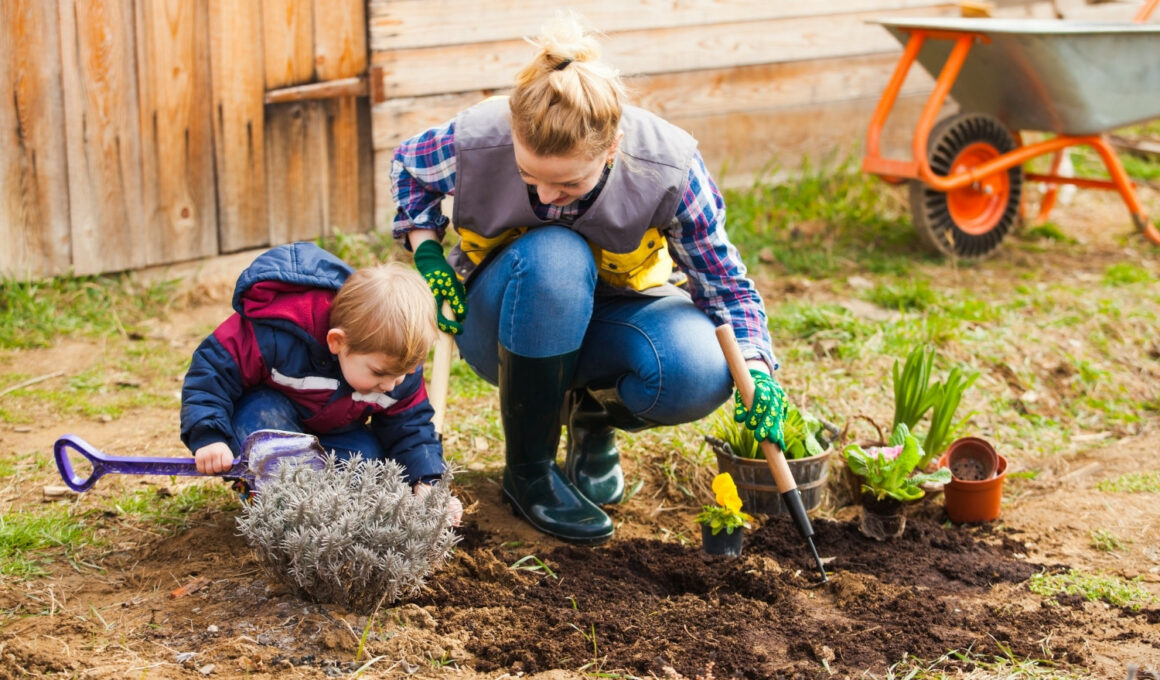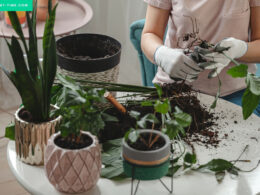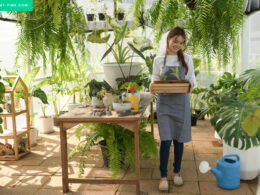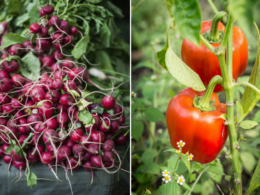In This Article Show
As a mom of three with a penchant for nurturing both children and plants, I’ve found a special kind of joy in the garden. It’s where life’s complexities fade into the background, leaving space for growth, not just for blooms and greens but for our family too.
If you’re looking to add a touch of green to your life, or perhaps you’re seeking a hobby that can provide a little peace in our all-too-busy days, you’re in the right place. Gardening is more than just a pastime—it’s a slice of nature that you curate and learn from, an outdoor canvas where life’s simple pleasures unfold.
And let’s be clear, you don’t need a degree in botany or an endless supply of time to make a garden flourish. With a few basic skills and your natural maternal instincts, you’ll be set to grow a thriving garden that reflects the care and love you pour into it.
So, whether you have a sprawling backyard or a modest balcony space, this guide is tailored for moms who are ready to grow their gardening confidence. Let’s cultivate a space where you and your plants can thrive together—spade in hand and kids in tow, one seedling at a time.
Getting Started with Your Garden
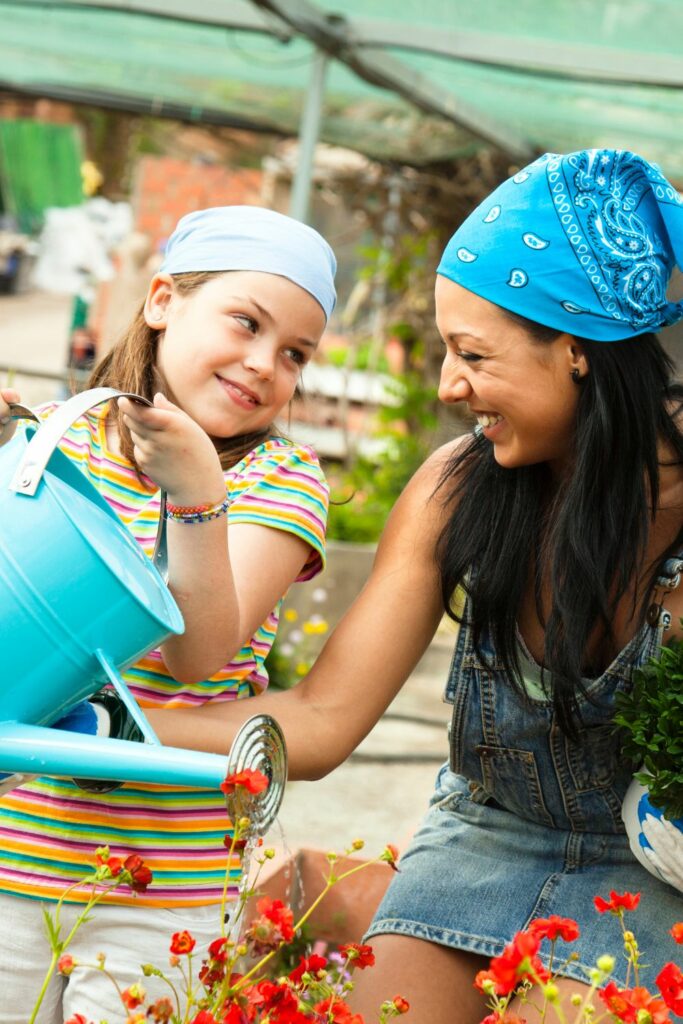
Embarking on your gardening journey begins with laying the groundwork for a flourishing space. As moms, we know that the right environment can nurture growth in any aspect of life, and the same goes for gardening. Let’s walk through the foundational steps to ensure your garden is set for success from the very beginning.
Choosing the Right Location for Your Garden
The location of your garden can make all the difference. Look for a spot that gets plenty of sunlight — most vegetables and flowers bask in at least six to eight hours of direct sunlight per day. But don’t fret if your space isn’t sun-drenched; there are plenty of plants that thrive in partial shade as well.
Great deals to snatch for your little ones 🎉
Also, consider convenience. A garden that’s easy to access for watering and maintenance is more likely to be tended regularly. So, pick a spot that’s close to a water source and sheltered from strong winds, yet visible enough to remind you of its presence every day.
Deciding on the Garden Type and Style
Do you envision a vegetable patch, a fragrant herb garden, or a vibrant flower bed? Your lifestyle will play a significant role in this decision. If meal prep is a significant part of your day, a kitchen garden with fresh herbs and veggies might be perfect.
On the other hand, if you’re seeking beauty and relaxation, ornamental flowers could be your go-to. And let’s not forget style — raised beds, container gardens, and traditional in-ground plots are all great options. Each has its advantages, whether it’s controlling soil conditions, ease of maintenance, or aesthetic appeal.
Soil Preparation Basics
Good soil is the cornerstone of any successful garden. Begin by getting a feel for your soil type — is it clayey, sandy, or loamy? The ideal garden soil is rich in organic matter and well-draining.
You might need to amend your soil with compost or well-rotted manure to improve its quality. Don’t skip a simple soil test, which can reveal the pH and nutrient levels, helping you adjust the soil conditions to meet the needs of your plants.
Essential Gardening Tools and Equipment for Beginners
You don’t need a shed full of tools to start gardening, just a few essentials. A sturdy spade or shovel for digging, a good-quality hoe for weeding and shaping soil, a hand trowel for transplanting, pruning shears for trimming, and a watering can or hose are all critical.
And don’t overlook the importance of a comfortable pair of gloves to protect your hands. As you become more entrenched in the gardening world, you’ll find which tools you reach for most often and what additional equipment might make your gardening more efficient and enjoyable.
Remember, the process of starting your garden is as rewarding as seeing your plants thrive. Take your time to set it upright, and you’ll be on your way to cultivating not only plants but also moments of peace and accomplishment in your gardening journey.
Planning Your Garden Layout
Crafting the layout of your garden is much like setting the stage for a play. Each element plays a role, contributing to the overall aesthetic and health of your garden.
Let’s break down the essentials of planning your garden layout so that your plot not only blossoms with life but also resonates with your style and practical needs.
Basics of Garden Design: Form, Texture, and Color
The beauty of a garden lies in its variety and balance. The form, or shape, of the plants you choose, will guide the eye and create structure. Consider a mix of vertical accents, like tall grasses or sunflowers, and low, spreading plants for ground coverage.
Texture in a garden comes from the foliage — the lush, smooth leaves of hostas contrast beautifully with the fine, feathery fronds of ferns. Finally, color is the magic that brings the garden to life.
While vibrant flowers are a go-to, remember that greenery comes in various shades and can be just as captivating. Strive for a palette that pleases you but also consider how colors might attract pollinators or how they’ll look in different seasons.
How to Plan for Sunlight and Shade in Your Garden
Your garden’s exposure to sunlight and shade will largely determine what you can grow. Observe your garden space throughout the day to understand how the sun moves across it.
Full-sun plants need about six to eight hours of direct sunlight, while those that require partial shade can thrive within four to six hours. There are also plants adapted to grow in full shade.
When planning your layout, place taller plants in a position where they won’t cast shadows on shorter, sun-loving ones, and use the shaded spots for plants that can flourish without much direct light.
Companion Planting: What It Is and How to Use It Effectively
Companion planting is the practice of placing plants together that can benefit each other in growth or pest control. This method is not just about maximizing space but also about creating a harmonious ecosystem.
For instance, marigolds emit a scent that deters garden pests, making them great companions for vegetables.
Similarly, planting basil near tomatoes is believed to improve their flavor. Companion planting can also be used for aesthetic purposes, like combining plants with complementary colors or staggering bloom times for a longer display.
By understanding the relationships between different plants, you can create a garden that is not only beautiful but also sustainable and healthy.
In your garden layout, balance functionality with beauty. Integrate paths for easy access, ensure each plant has room to grow, and consider the overall view from inside your home or sitting area.
A well-planned garden is a joy to maintain and becomes a personal retreat that reflects the unique touch of its gardener — in this case, a dedicated mom with a vision for a verdant, vibrant life.
Plant Selection and Care
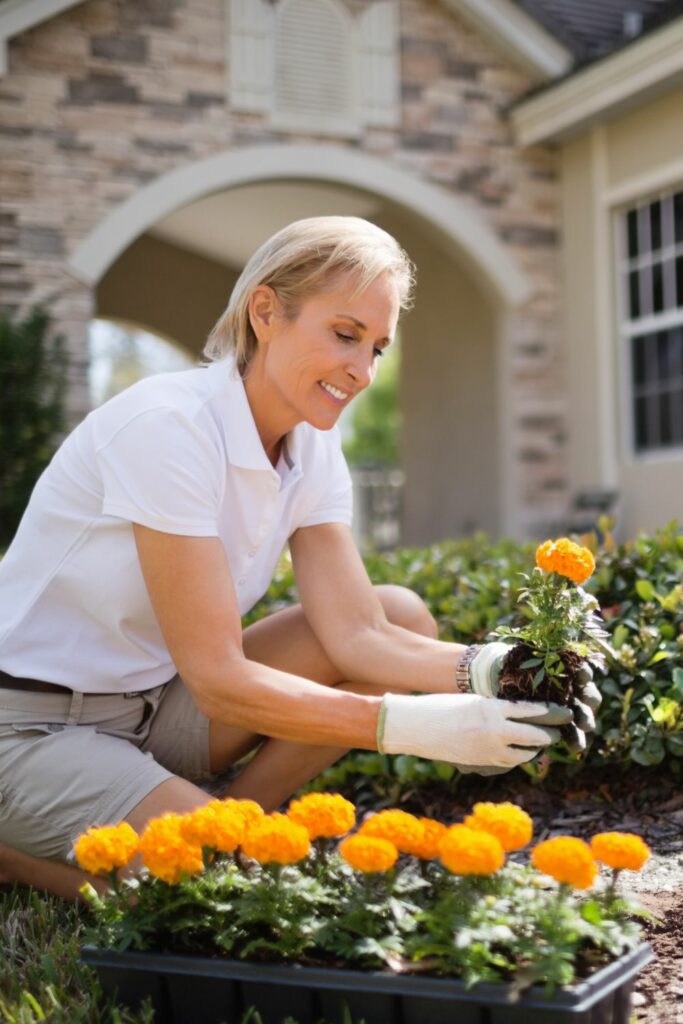
Selecting the right plants for your garden and providing them with the care they need can be likened to curating a collection — each addition should be intentional and well thought out. Let’s go over how to pick the plants that will thrive in your garden’s unique conditions and understand the care they require.
How to Choose Plants Suitable for Your Garden’s Conditions
The secret to a low-maintenance yet thriving garden is to work with your garden’s natural conditions rather than against them. Start by assessing your garden’s light levels, soil type, and climate zone. Armed with this information, you can select plants adapted to these conditions.
Native plants are often a good choice as they are already suited to the local environment and require less upkeep.
Consider also the water requirements of each plant — in regions prone to drought, for instance, drought-tolerant plants will be more sustainable. Lastly, think about the growth habits and mature size of plants to ensure they have enough room to flourish without overcrowding.
Understanding Plant Labels and What They Mean
Plant labels are your go-to guide and should be read thoroughly before making a purchase.
These labels provide critical information such as the plant’s common and scientific name, the sunlight requirements (full sun, part sun, shade), water needs, growth habits (height and spread once mature), and other special considerations such as preferred soil type, bloom time, and whether it’s an annual or perennial.
labels might also include information on the hardiness zone, which indicates the climate conditions the plant is suited to. By understanding these details, you can make informed choices and place plants in your garden where they will thrive.
Tips for Planting, Watering, and Maintaining Your Plants
Planting
When planting, make sure you dig a hole twice as wide as the root ball of the plant to give roots ample room to spread out. Avoid planting too deep — the base of the plant should be level with the soil surface.
Watering
Consistent watering is key, especially for new plants. Aim to keep the soil moist but not waterlogged. Overwatering can be just as harmful as underwatering, leading to root rot. Establish a watering schedule based on the needs of your plants and the weather conditions.
Maintaining
Mulching is an excellent practice for retaining soil moisture, regulating soil temperature, and suppressing weeds. Pruning helps maintain plant health by removing dead or diseased wood and encouraging fresh growth. Learn the specific needs of each plant, as some may require staking or special care during the blooming period.
Remember, gardening is not a one-size-fits-all hobby. It requires observation and adaptation. Plants are living things that respond to their environment, and as a gardening mom, you’ll become attuned to their needs, just as you are with your children.
With a nurturing approach and a willingness to learn from the garden itself, you’ll find your green thumb grows stronger with each passing season.
Gardening Activities for the Whole Family
Gardening can be a delightful family affair, a way to bond with your children while instilling in them a love for nature and an understanding of where food comes from. It’s also an opportunity to teach responsibility, as plants require care just like pets. Let’s look at some ways to get the whole family’s hands dirty in a fun and educational manner.
Fun Gardening Projects for Kids
Kids love to see the fruits of their labor, so start with fast-growing plants that will hold their interest. Radishes, sunflowers, and nasturtiums can be gratifying for little gardeners.
Create a pizza garden by planting tomatoes, basil, and peppers, which you can later use to cook a meal together. Another fun project is a butterfly garden — choose plants like milkweed, lavender, and marigolds to attract these beautiful insects and provide a learning experience about pollinators.
How to Involve Your Family in Gardening Activities
Give each family member their small plot or container to take care of — this gives them autonomy and pride in what they grow. Involve them in every step, from selecting seeds to harvesting.
For younger children, use gardening activities as a chance to practice counting and colors; for older children, it can be an exercise in responsibility and science.
Ensure you have child-friendly tools and tasks suitable for their age and skill level to keep them engaged and safe.
Teaching Kids about Nature through Gardening
Gardening is a hands-on way to teach children about the life cycle of plants, the importance of biodiversity, and the impact of weather and seasons on the environment.
Encourage them to keep a journal of what they observe, including what plants are growing, what insects visit, and how the garden changes over time. Discuss the role of earthworms in soil health, the process of photosynthesis, and the way plants contribute to the air we breathe.
Most importantly, teach them the value of sustainability — how composting kitchen scraps can feed their garden and why conserving water is essential.
Through these family-oriented gardening activities, not only will your garden flourish, but the memories you create together will root deeply, much like the plants in your shared space.
By fostering a family environment that values the rhythm of nature, you are sowing the seeds for a lifetime of environmental respect and sustained interest in the joys of gardening.
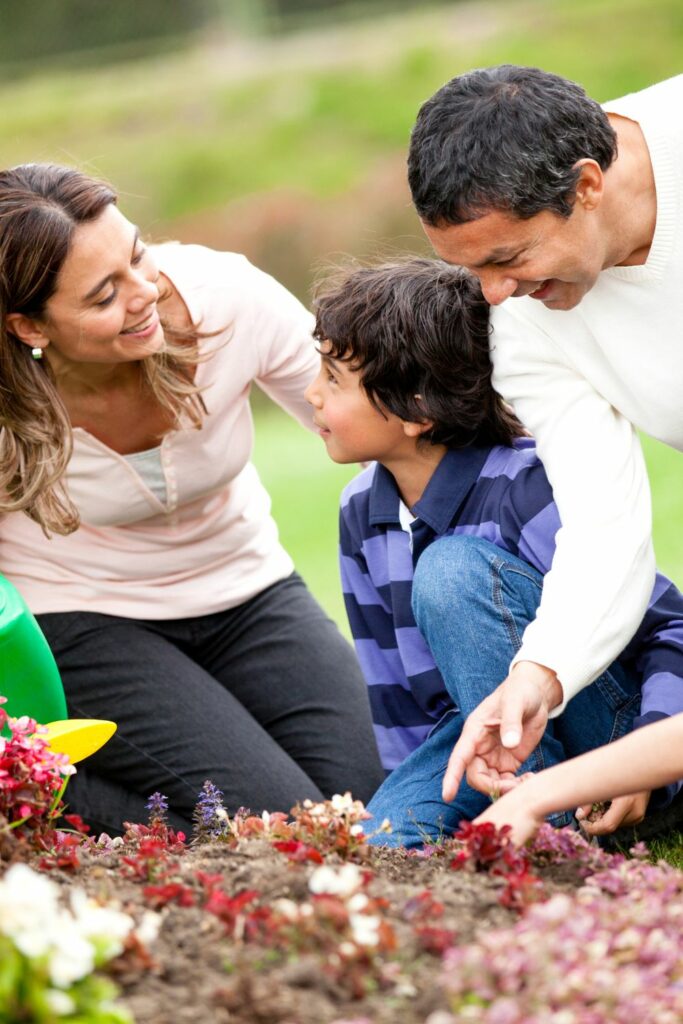
Managing Garden Pests and Problems
Tending to a garden is not without its challenges, especially when it comes to pests and diseases. A proactive approach and a bit of know-how can help you manage these issues effectively, keeping your garden healthy and thriving.
Identifying Common Garden Pests and Natural Remedies
Knowledge is power when it comes to pests. Some common culprits include aphids, slugs, and caterpillars. Aphids, tiny sap-sucking insects, can be dislodged with a strong jet of water or controlled with applications of soapy water or neem oil.
Slugs, which feast on leaves during the night, can be deterred with diatomaceous earth or traps.
Caterpillars require a bit more vigilance; hand-picking can be effective, but for organic control, Bacillus thuringiensis (Bt), a natural bacterium, can be used.
How to Deal with Plant Diseases
Plant diseases often manifest as discoloration, wilting, or spotting on leaves. Prevention is the best cure, so ensure good air circulation by not overcrowding plants and watering the base rather than the foliage.
If diseases do appear, remove and destroy affected plant parts to prevent spreading. For fungal issues, treatments such as sulfur or copper-based fungicides can be used, though it’s best to use these products sparingly and as directed.
Organic Versus Chemical Treatments: Pros and Cons
When weighing the options between organic and chemical treatments, consider the environment, your family’s health, and the long-term effects on your garden’s ecosystem.
Organic Treatments
These include substances like neem oil, insecticidal soaps, and natural predators like ladybugs. The pros are that they are safer for the environment, non-toxic to children and pets, and they support beneficial insects. However, they may take longer to work and might need more frequent application.
Chemical Treatments
These can provide a quick solution to severe infestations and are sometimes necessary when all else fails. However, they can also harm beneficial insects, lead to resistance to pests, and potentially affect the health of soil and nearby water sources.
In every case, it’s crucial to correctly identify the problem before treating it. Integrated Pest Management (IPM) is a balanced approach that involves monitoring pests, setting action thresholds, and applying controls carefully.
By being mindful of the methods you choose, you’re not just protecting your garden, but you’re also safeguarding the ecosystem your garden is a part of.
Remember, a healthy garden exists in harmony with its natural surroundings, and sometimes that means tolerating a few pests as part of the greater landscape of life.
Harvesting and Enjoying the Fruits of Your Labor
The culmination of all your gardening efforts is the harvest. There’s a distinct satisfaction that comes from plucking fresh produce from your garden and using it to nourish your family. Let’s explore the best ways to determine when your labor of love is ripe for the picking and how to savor every bite.
How to Know When Your Produce Are Ready to Harvest
Harvesting at the right time is crucial for the best flavor and nutritional value. Here’s a quick guide to help you:
- Tomatoes: Harvest when they are brightly colored and firm, with a slight give.
- Peppers: They can be picked when they reach the desired size and color, but the longer they’re left on the plant, the sweeter they become.
- Leafy Greens: Pick leaves from the outside of the plant when they are tender and full-sized.
- Root Vegetables: Such as carrots and radishes, often indicate readiness when their tops peek out of the soil.
- Berries: Wait until they are full color and come off easily when gently tugged.
Each plant has its signals, so familiarize yourself with these cues. Often, tasting a small sample can be the best indicator.
Ideas for Using Your Garden Produce in Family Meals
Incorporating your garden bounty into family meals can be a joyous occasion. Create a salad with your greens, herbs, and edible flowers for a start.
Use your tomatoes and basil for a fresh pasta sauce, or bake them into a vegetable lasagna. Zucchinis can be turned into noodles for a healthy twist, or they can be grated into bread and muffins.
The possibilities are truly endless, and involving your family in cooking with ingredients they’ve helped to grow fosters appreciation and enjoyment of the food.
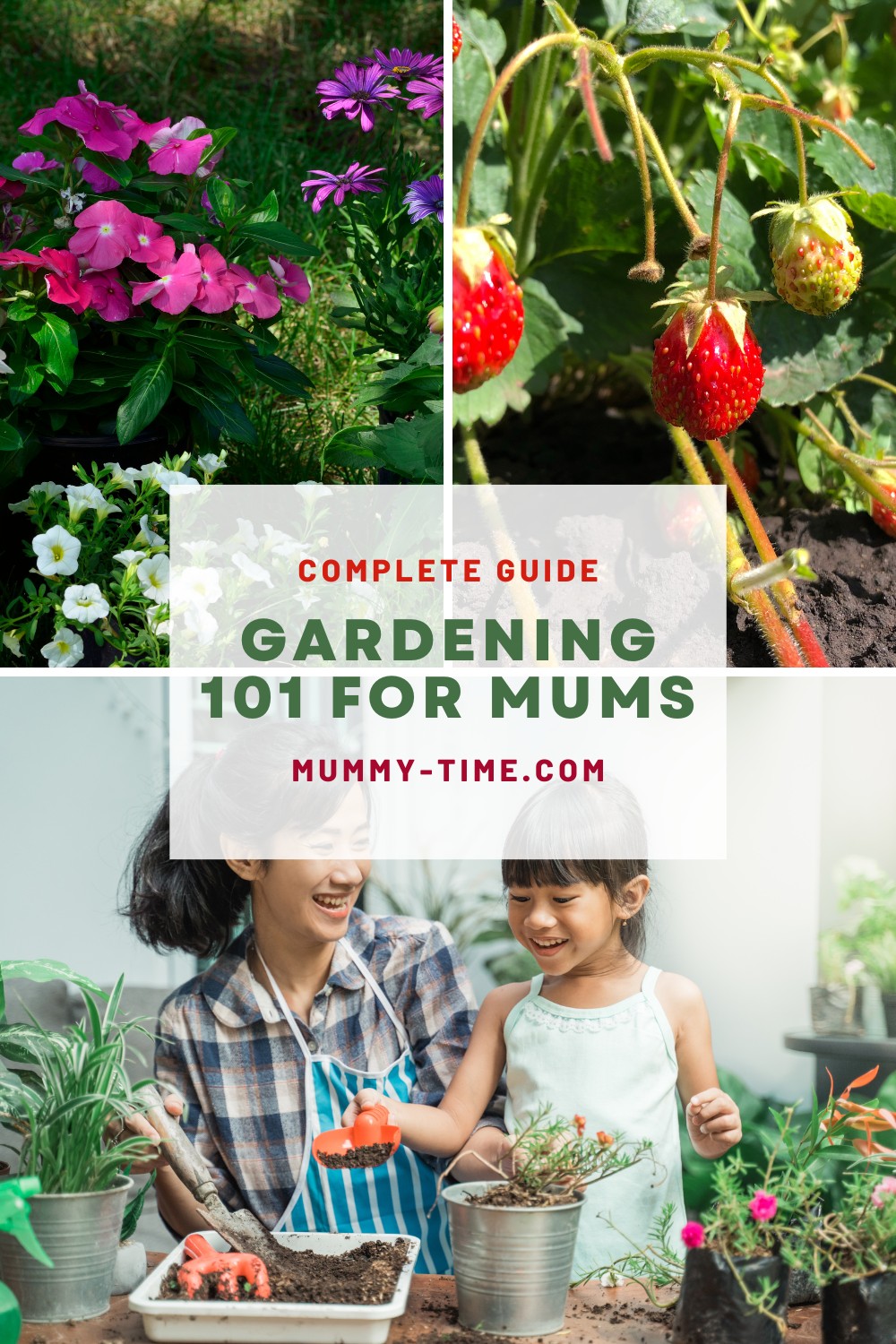
Preserving Your Harvest: Simple Canning and Freezing Tips
If you find yourself with more produce than you can use immediately, preserving it allows you to enjoy your harvest even in the off-season.
- Canning: This method is great for tomatoes, cucumbers, and fruits. Ensure you follow a tested recipe and use the proper canning equipment to ensure food safety.
- Freezing: Almost all vegetables will need to be blanched before freezing. Fruits can be frozen whole or in slices on a tray before transferring them to airtight containers or freezer bags.
Blanching — briefly cooking in boiling water, then cooling rapidly in ice water — stops enzyme activity that can cause loss of flavor and texture.
Remember to label and date your preserved goods. Whether you’re enjoying crisp pickles in the middle of winter or making strawberry jam for your breakfast, these methods allow you to extend the delight of your garden’s yield.
Extending Your Gardening Season
For those who love to get their hands in the soil, there’s no need to limit gardening to the traditional spring and summer months. With a few strategies, you can extend your gardening season to enjoy growing and harvesting almost all year round.
Tips for Gardening in Different Seasons
- Spring: Start early by using cold frames or a greenhouse to protect seedlings from late frosts. Choose cool-weather crops like lettuce, spinach, peas, and radishes, which can handle the chill.
- Summer: Plant heat-tolerant varieties and use mulch to retain soil moisture. This is the time for tomatoes, peppers, cucumbers, and beans to thrive.
- Fall: Extend the harvest by planting late-season varieties of greens and root vegetables. Some, like kale and carrots, can handle frost and even taste sweeter after a cold snap.
- Winter: Use season extenders like row covers and cold frames to protect plants from frost. In milder climates, you can grow hardy vegetables such as Swiss chard, collards, and some herbs.
How to Protect Your Plants from Weather Extremes
Protection from the elements can mean the difference between a thriving garden and a struggling one.
- Heat: Use shade cloths to protect plants from intense midday sun, and water either early in the morning or late in the evening to reduce evaporation.
- Cold: Employ cloches, row covers, and cold frames to guard against frost. Choosing the right location, such as a south-facing wall for additional warmth, can also be beneficial.
- Wind: Set up windbreaks like hedges, fences, or even temporary burlap barriers to shield sensitive plants.
Indoor Gardening Basics for Year-Round Enjoyment
Don’t let the lack of outdoor space or harsh weather stop you. Indoor gardening is a fantastic way to keep your green thumb active throughout the year.
- Lighting: Most indoor plants need bright, indirect light. South-facing windows are ideal, but if natural light is limited, consider grow lights.
- Container Selection: Ensure containers have drainage holes and are large enough to accommodate the growth of your plants.
- Soil: Use a high-quality potting mix suited for indoor plants. It’s lighter than outdoor soil, promotes good drainage, and minimizes pests and diseases.
- Watering: Overwatering is a common issue. Check the top inch of soil for dryness and water accordingly. Always allow excess water to drain out.
- Humidity: Many houseplants benefit from higher humidity levels than typical homes offer. A humidifier, pebble tray, or regular misting can help.
Whether you’re prepping for the cold by moving herbs indoors, selecting frost-resistant species, or utilizing a sunny windowsill for a miniature herb garden, there are ample ways to keep your connection with plants strong.
Each season has its unique charm and set of activities, and with a bit of creativity, you can cultivate the art of gardening throughout the year, no matter the weather outside.
Gardening Resources for Moms
Whether you’re a seasoned gardener or just starting to explore the wonders of growing your plants, there’s always more to learn.
Fortunately, a wealth of resources is available at your fingertips to help you deepen your gardening knowledge and connect with a community of like-minded enthusiasts.
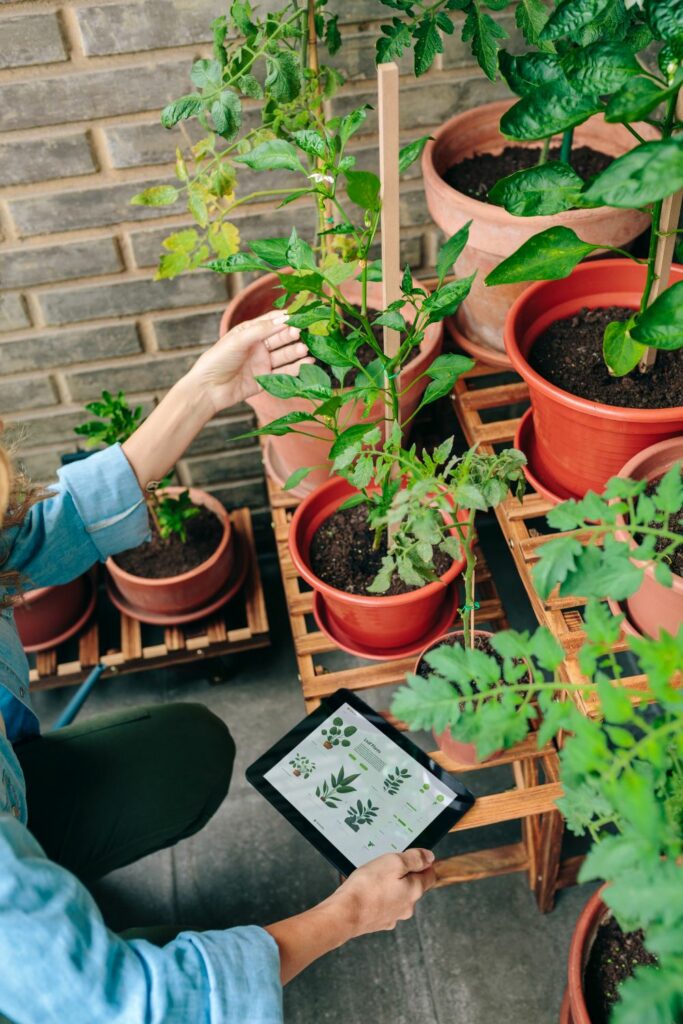
Best Gardening Apps and Websites for Ongoing Advice
Apps
- GardenTags is an app that offers a plant identification service and a platform for gardeners to ask questions and share advice.
- GrowIt! allows you to join a community of local gardeners where you can ask questions, share your gardening successes, and get inspiration for your next plantings.
- My Garden by Gardena is a digital garden planner where you can design your garden and get personalized planting and care instructions.
Websites
- The Old Farmer’s Almanac (almanac.com) provides planting calendars based on your local climate, frost dates, and moon phases, which are essential for planning your garden.
- Gardeners’ World (gardenersworld.com) is packed with how-to guides, videos on gardening techniques, and forums for asking questions and getting advice.
Recommended Books for Gardening Enthusiasts
- “The Vegetable Gardener’s Bible” by Edward C. Smith is renowned for its useful information on high-yield, raised bed gardening.
- “Rodale’s Basic Organic Gardening” by Deborah L. Martin offers a no-fuss guide for beginners, with details on organic gardening basics.
- “The Flower Gardener’s Bible” by Lewis and Nancy Hill is perfect for those who want to focus on creating a stunning, colorful garden that’s in bloom throughout the seasons.
Local Gardening Clubs and Online Communities
Local Clubs
Check your local library’s bulletin board, your city’s community website, or resources like the American Horticultural Society’s website to find a gardening club near you.
These clubs often offer workshops, plant swaps, and opportunities to get involved with community gardens.
Online Communities
- GardenWeb (now part of Houzz) is one of the oldest and largest gardening communities on the web where you can discuss with fellow gardening enthusiasts.
- Reddit has various subreddits such as r/gardening and r/landscaping where you can find a wealth of information and personal experiences.
- Facebook Groups: There are numerous groups dedicated to gardening where you can share photos, participate in discussions, and seek advice.
These resources can help you deepen your gardening knowledge, stay current with best practices, and connect with other gardening moms.
They can serve as your go-to guide for quick advice on troubleshooting plant issues, discovering new gardening techniques, and finding inspiration for your next gardening project.
With the support of these apps, websites, books, and communities, you’ll have all the tools you need to grow your gardening skills and your garden.






